Bombardier Flexity Classic
The Bombardier Flexity Classic is a model of light-rail tram manufactured by Bombardier Transportation. Although it is marketed as the most traditionally designed member of the Flexity family, it is nevertheless a modern bi-directional articulated tram with a low-floor section allowing good accessibility, especially to passengers in wheelchairs. Flexity Classic trams run on 1,435 mm (4 ft 8 1⁄2 in) standard gauge in Australia, 1,000 mm (3 ft 3 3⁄8 in) metre gauge in Essen, 1,450 mm (4 ft 9 3⁄32 in) in Dresden, and 1,458 mm (4 ft 9 13⁄32 in) in Leipzig.
Flexity models operate in a number of German cities; Norrköping and Stockholm in Sweden; Kraków and Gdańsk in Poland; and Adelaide in South Australia.
The Flexity Classic’s closest competitors are Alstom’s Citadis, the Combino and Avanto from Siemens, and Bombardier's other Flexity trams.
Adelaide
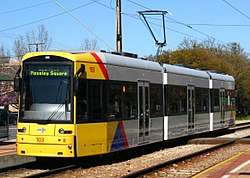
In 2006 TransAdelaide began to replace the Type H cars operating on the Glenelg tram line with 11 Flexity Classic trams built in Bautzen, Germany by Bombardier Transportation. The first of the new cars was delivered to the Glengowrie depot in November 2005 and entered revenue service on 9 January 2006. As they were delivered through 2006 the new trams operated side-by-side with the Type H cars that had been operating the service since 1929. (Those trams were withdrawn progressively until five ran on special occasions; since 2015 they have been in storage.) A further order of four in 2008 brought the total to 15, numbered 101–115.
The Flexity cars are painted in a standard Adelaide Metro colour scheme of white with yellow, blue and red ends, very similar to Adelaide’s metropolitan bus fleet. However, many now display "all-over advertising" that considerably alters their appearance, with only the yellow ends untouched.
The trams have low floors throughout 70 per cent of their length, and are accessible to pushchairs and wheelchairs through each of the three sets of doors. Their features include air conditioning, heating, recorded video surveillance and automated audio and visual announcements of the next stop. Roving conductors are employed.
The internal layout accommodates 64 seated passengers and another 115 standing. Initial overcrowding owing to the popularity of the rejuvenated Glenelg line and the short route extension through the business area of Adelaide, and the inadequacy of air conditioning in Adelaide's hot summers, led to adverse reactions from commuters and local media, but the faults were soon rectified and supplementation by Type 200 Alstom Citadis trams has minimised overcrowding.
Specifications
| Flexity trams | |
|---|---|
| Track gauge: | 1,435 mm (4 ft 8 1⁄2 in) standard gauge |
| Power source: | 600 V DC overhead wire |
| Traction: | 4 motors |
| Number in class: | 15 |
| Unit numbers: | 101–115 |
| Introduced: | 2006 (11), 2008 (4) |
| Built by: | Bombardier Transportation, Bautzen, Germany |
| Passenger capacity: | 64 seated; 115 standing |
| Weight: | 40 tonnes (39 long tons; 44 short tons) |
| Length: | 30 m (98 ft 5 1⁄8 in) |
| Width: | 2.4 m (7 ft 10 1⁄2 in) |
Dresden and Leipzig
_at_Altmarkt%2C_Dresden.jpg)
The Flexity Classic XXL model was developed for the Dresden Transport Authority by the German factory Bombardier Transportation in Bautzen. It is 45 m (147 ft 7 5⁄8 in) long, runs on twelve axles and has a capacity of 260 passengers with 153 seats. The Flexity Classic XXL (classification NGT D12DD) has, because of Dresden's altitude differences of 100 metres (330 ft), a power-to-weight ratio of 112 kg/hp (247 lb/hp; 150 kg/kW). The tram has been in service since 2003 and serves tram lines with a high peak load of passengers. The exterior is specially designed for the Dresden Transport Authority, which owns 43 trams.
The Flexity Classic XXL is also in service in Leipzig, Germany (classification NGT12-LEI) with the Leipzig Transport Authority (LVB). Although the exterior design is customized, the tram offers the same capacity. It has been in service since 2005. The LVB first ordered 12 trams of this type, then exercised an option for another 12 trams in September 2005 and a third (slightly changed) batch of 9 was delivered in late 2011/early 2012.
Around the world
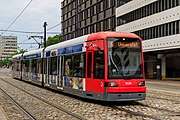
.jpg)
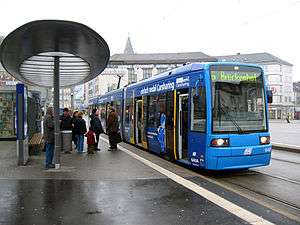 One out of ten bi-directional Flexity Classic trams in Kassel, Germany
One out of ten bi-directional Flexity Classic trams in Kassel, Germany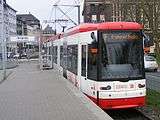 NGT8 type Flexity Classic at the Harbor station of the “DSW21” network in Dortmund, Germany
NGT8 type Flexity Classic at the Harbor station of the “DSW21” network in Dortmund, Germany
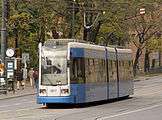
 Flexity Classic on the Spårväg City Line (an extension of the Djurgården Line) in Trams in Stockholm, Sweden
Flexity Classic on the Spårväg City Line (an extension of the Djurgården Line) in Trams in Stockholm, Sweden- Flexity Classic on the tramway in Norrköping, Sweden